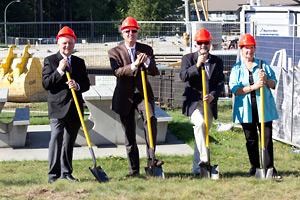Officials held a groundbreaking ceremony September 11 for Willingdon Creek Village. The $26.5-million project to replace Olive Devaud Residence is slated to open in early 2015.
“Through Willingdon Creek Village, the legacy of caring for our aging citizens in the Powell River region, as well as the vision of Nurse Olive Devaud and the Powell River Sunset Homes Society, will continue,” said Colin Palmer, chair of the Powell River Regional Hospital District Board. “On behalf of the directors of the regional hospital district board, I want to thank everyone who has committed their time and talents to reach this significant point in the project’s history.”
The regional hospital district is financing the project, while Vancouver Coast Health (VCH) is the project manager and will run the facility once it is constructed.
Olive Devaud Residence, an 81-bed facility constructed in 1966, was not designed to meet the complex needs of today’s residential care clients. The 102-bed replacement facility will feature an updated, modern design and offer efficiencies in housekeeping, laundry, nutritional services and facilities maintenance due to its proximity to Powell River General Hospital.
Along with Palmer, Kip Woodward, VCH board chair, City of Powell River Mayor Dave Formosa, Wendy Hansson, VCH chief operating officer, and Lorraine Hansen, president of Powell River Health-Care Auxiliary, spoke at the ceremony. Tla’amin (Sliammon) First Nation elder Dr. Elsie Paul gave a blessing as well.
“Anchoring a community with a hospital gives it its economic underpinnings for generations to come,” said Woodward.
Hansson said Willingdon Creek Village will have “wider doorways that make the entire facility wheelchair accessible,” she said. “There will be wandering paths for residents with cognitive impairment, larger overall room sizes enabling single occupancy with dedicated washrooms and dedicated ceiling lifts for each of the residents.” There will also be space for an expanded adult daycare program.
Hansson pointed out that 35 per cent of the workers on the project are local residents.
The health-care auxiliary donated more than $877,000 for equipment at the facility.



